How to Plant Peony: Easy Steps for Blooming Success
- April 5, 2024
- 2 comment
Peonies, with their lush foliage and magnificent blooms, are a favorite in many gardens. These perennial beauties are known for their durability, longevity, and minimal care requirements, making them an ideal choice for gardeners of all skill levels. Here’s a comprehensive guide on how to plant and care for your peonies.
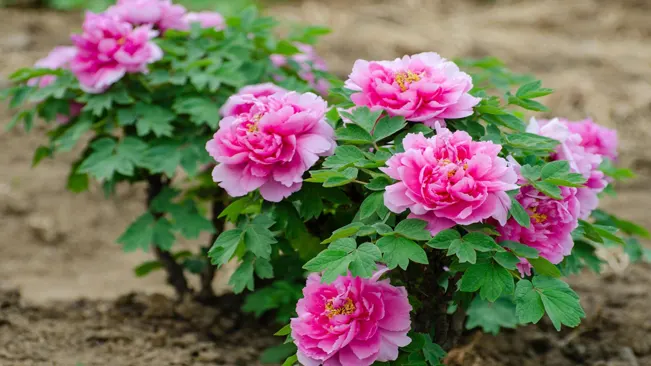
List on How To Plant Peony
- Selecting Your Peonies
- When to Plant
- Choosing the Right Spot
- Planting Your Peonies
- Post-Planting Care
- Common Challenges
Selecting Your Peonies
Types of Peonies
Herbaceous Peonies
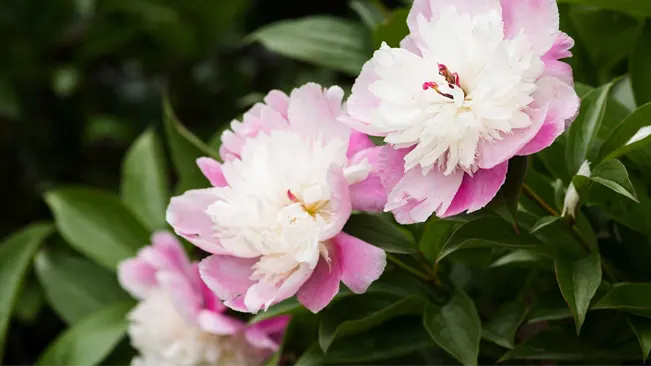
- These are the most common type found in gardens.
- Characteristic: They grow from roots each spring, bloom in late spring to early summer, and die back to the ground in winter.
- Maintenance: Require minimal care once established and are known for their longevity, often living for decades.
- Varieties: Include a wide range of flower forms like single, double, semi-double, and Japanese-style blooms.
Tree Peonies
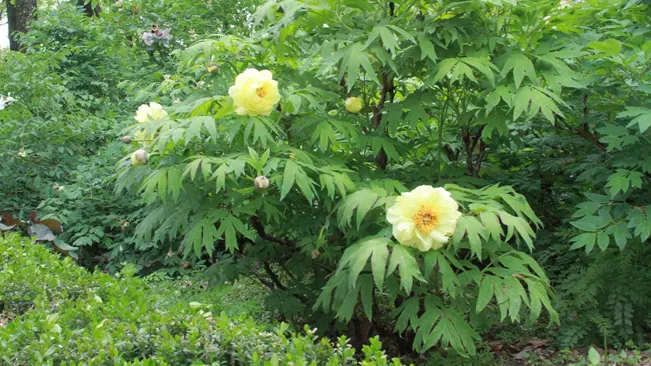
- Distinct from herbaceous types, tree peonies have a woody structure that remains above ground year-round.
- Blooms: Produce larger and often more vibrant flowers than herbaceous peonies.
- Lifespan: Can live even longer than herbaceous varieties, sometimes for over a century.
- Growth: They grow slower and can reach up to 4-5 feet tall at maturity.
Itoh or Intersectional Peonies
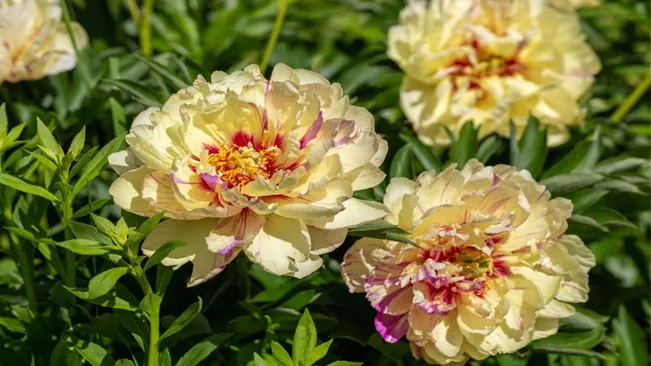
- A hybrid between herbaceous and tree peonies.
- Characteristics: They have the hardiness and flower form of herbaceous peonies and the leaf shape and bloom size of tree peonies.
- Blooming: Often have a more extended blooming period than the other types.
- Maintenance: Require similar care to herbaceous peonies and die back to the ground in winter.
Color and Variety
- Color Palette
- Ranges from pure white and soft pastels to deep, rich reds and even yellow tones.
- The variety in color makes peonies highly versatile for garden design.
- Multi-Colored Varieties
- Some peonies have petals with multiple colors, adding an exotic charm to the garden.
- These varieties can have petals with different colored edges, centers, or both.
- Selecting the Right Color
- Choose colors that complement or contrast with your garden’s existing color scheme.
- Consider bloom time and plant height as well, to create a harmonious and staggered blooming period in your garden.
When to Plant
Ideal Season: Autumn
- When to Plant: The most suitable time for planting peonies is in autumn, typically around six weeks before the soil begins to freeze. This period often corresponds to late September through October, although specific timing may vary based on your local climate.
- Reason for Timing: Planting in autumn is crucial as it allows peony roots to establish in the soil during a period when the earth remains warm enough to foster root growth.
- Advantages: By establishing their roots in autumn, peonies gain an early advantage for the upcoming growth season. This head start means that come spring, they are already equipped with a robust root system, enabling vigorous sprouting.
Alternative Season: Spring
- When to Plant: Should autumn planting be unfeasible, early spring is the next best option. Begin planting when the soil can be worked and the threat of intense frost has subsided.
- Challenges: The primary obstacle with spring planting is ensuring that the peonies have ample time to settle before the summer heat. They might also need extra care and consistent watering due to fluctuating spring temperatures.
- Precautions: If planting in spring, be wary of too early a start, especially if late frosts are common in your area, as this can harm new growth.
Choosing the Right Spot
Sunlight
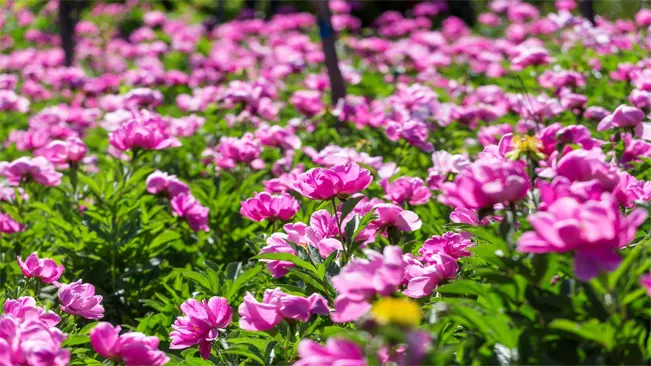
- To ensure the health and vibrancy of peonies, it’s crucial to plant them in locations where they will receive the necessary six to eight hours of direct sunlight daily. Failure to meet these sunlight requirements can lead to weakened plant growth, fewer or no blooms, and an increased risk of diseases.
Soil Conditions
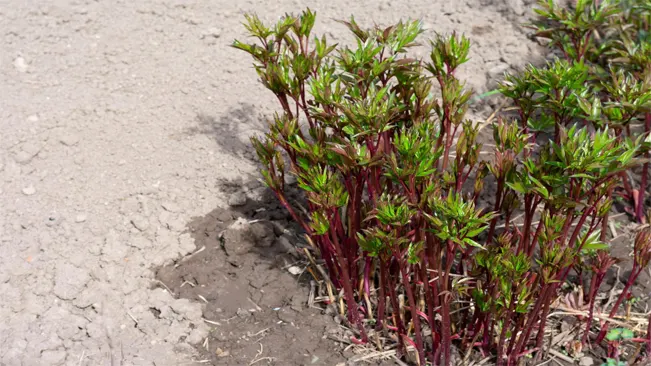
- Ensure well-drained soil to prevent waterlogging and associated diseases like root rot. Improve heavy clay soils by adding organic materials like compost or well-rotted manure, enhancing soil structure and drainage for robust root development. While peonies are adaptable, they favor a neutral to slightly alkaline soil pH; consider testing and adjusting your soil’s pH for optimal growth conditions.
Spacing
- Room for Growth: Proper spacing is crucial for air circulation and sunlight penetration, which helps prevent disease and encourages strong growth.
- Spacing Herbaceous Peonies: These should be spaced about 2-3 feet apart. This distance allows them enough room to grow to their full size and prevents overcrowding, which can lead to competition for nutrients and increased humidity that fosters disease.
- Spacing Tree Peonies: Need more space, generally 4-5 feet apart, due to their larger size. They can grow quite tall and wide, and adequate spacing ensures they don’t overshadow or hinder the growth of neighboring plants.
Planting Your Peonies
Preparing the Soil
- Why It’s Important: Proper soil preparation is crucial for the health and growth of peonies. These plants thrive in rich, well-drained soil.
- Depth and Composition: Tilling the soil to a depth of 12-18 inches ensures that the roots have enough room to grow. This depth also helps in improving soil drainage and aeration.
- Enriching the Soil: Adding compost or well-rotted manure enriches the soil with organic matter, which peonies love. This addition not only feeds the plant but also improves soil structure and moisture retention.

Planting Depth
- For Herbaceous Peonies: Planting the buds (or “eyes”) 1-2 inches below the soil surface is ideal. This depth is crucial as planting too deep can prevent blooming, while too shallow planting might expose the roots to harsh weather.
- For Tree Peonies: The graft union, a noticeable bulge near the base of the stem, should be planted deeper, about 4-6 inches below the soil surface. This depth ensures the graft union is adequately protected and helps in the development of a strong root system.
Positioning the Plant
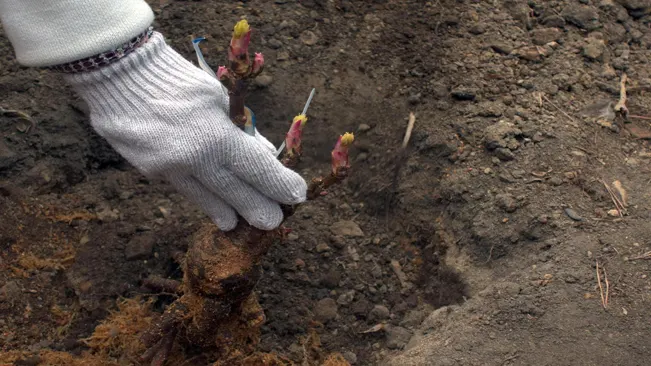
- Placement in the Hole: Carefully place the peony in the prepared hole, ensuring that the roots are spread out and not cramped or bent. This spreading helps the roots to grow outwards and downwards more effectively.
- Filling the Hole: Backfill the hole gently with soil. Avoid packing the soil too tightly, as this can hinder root growth and water penetration.
- Initial Watering: After planting, water the peonies thoroughly. This initial watering helps to settle the soil around the roots and eliminate any air pockets. Consistent moisture is key, especially in the first few weeks after planting, to ensure the roots establish well.
Post-Planting Care
Watering
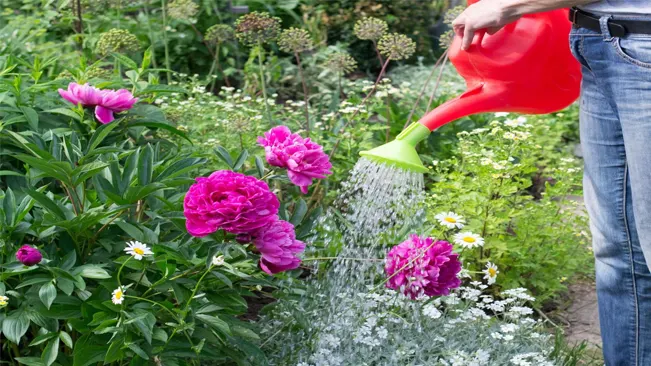
- Consistent Moisture: Peonies do well with soil that is consistently moist, particularly during their first growing season. This helps in establishing a strong root system.
- Avoid Overwatering: While consistent moisture is key, it’s also important not to overwater, as this can lead to root rot. Ensuring good drainage and allowing the top inch of soil to dry out slightly before watering again can be a good practice.
Fertilizing
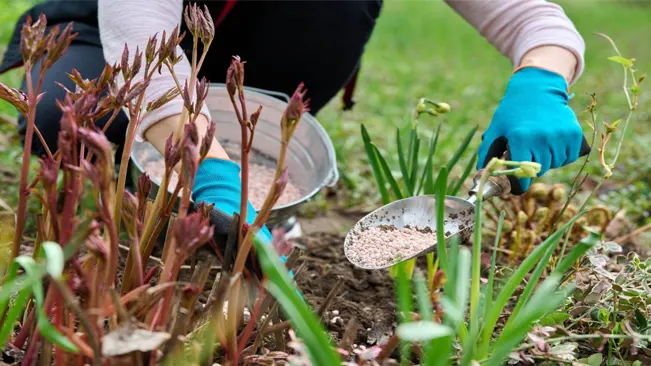
- Type of Fertilizer: A low-nitrogen fertilizer is recommended for peonies. High nitrogen content can lead to lush foliage at the expense of blooms.
- Timing: The best time to fertilize is in early spring when the new shoots are about 2-3 inches tall.
- Application Method: Apply the fertilizer around the drip line of the plant, avoiding direct contact with the stems or foliage to prevent burn.
Winter Care
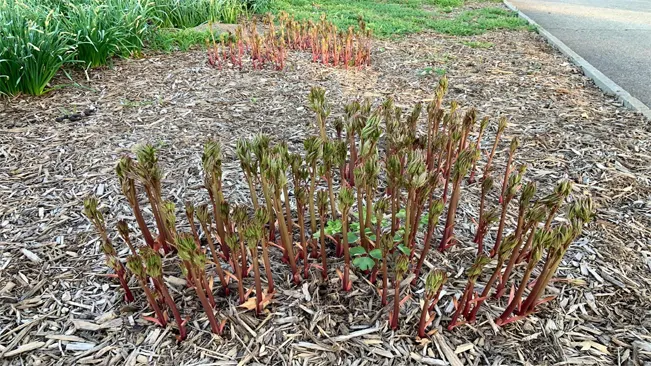
- Mulching: In colder climates, a layer of mulch applied after the ground freezes can protect the peonies’ roots from extreme temperature fluctuations.
- Type of Mulch: Use organic material like straw or shredded bark, which will also enrich the soil as it decomposes.
Pruning
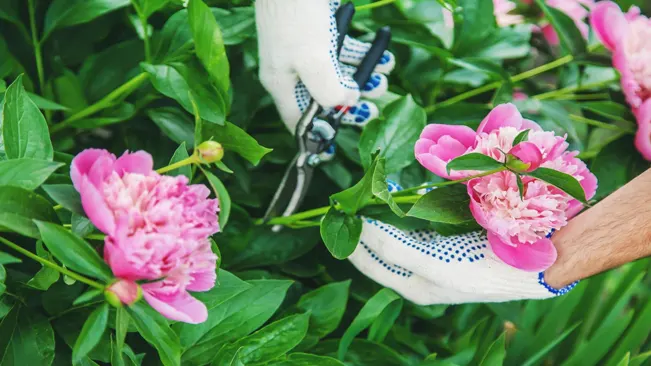
- Herbaceous Peonies: In the fall, once the foliage has died back, cut the stems of herbaceous peonies down to ground level. This helps prevent overwintering diseases and pests.
- Tree Peonies: For tree peonies, minimal pruning is needed. Just remove any dead or weak wood. This is typically done in late winter or early spring before new growth begins.
Common Challenges
Botrytis Blight

- What It Is: Botrytis Blight, caused by the fungus Botrytis cinerea, is a common disease affecting peonies. It typically appears in spring when the weather is cool and moist.
- Symptoms: The disease manifests as blackened buds, wilted and discolored stems, and gray mold on flowers and leaves. If left unchecked, it can cause significant damage to the entire plant.
- Prevention and Control:
- Air Circulation and Spacing: Proper spacing between plants ensures good air circulation, reducing the humidity that fosters fungal growth.
- Sanitation: Remove and destroy any affected plant parts immediately. Avoid overhead watering to keep foliage dry.
- Fungicides: In severe cases or as a preventative measure in humid climates, appropriate fungicides can be applied. However, it’s best to consult with a local gardening expert or extension office for specific recommendations.
Peony Ants

- What They Are: Peony ants are attracted to peonies, specifically to the sugary nectar that coats the flower buds.
- Behavior and Impact:
- Harmless to the Plant: Contrary to common belief, these ants do not harm the plant. They are merely attracted to the nectar and do not eat the flower buds.
- Beneficial Role: Some gardeners believe that ants play a role in helping peony buds to open, although this is more anecdotal than scientifically proven.
- Management:
- No Need for Control: Since peony ants are harmless, there’s usually no need to control them.
- Natural Disappearance: Once the flowers open and the nectar is no longer available, the ants typically move on of their own accord.
- Gentle Cleaning: If ants are present on cut peonies brought indoors, gently shake the flowers or rinse them to remove the ants.
Related Growing Guides:
Conclusion
Planting peonies can be a rewarding experience, leading to years of stunning blooms. With the right care and attention, these resilient plants can thrive in your garden, bringing beauty and elegance for many seasons..
FAQs (Frequently Asked Questions)
- When is the best time to plant peonies?
- The ideal time is in the fall, about six weeks before the ground freezes. However, if missed, early spring is also suitable.
- The ideal time is in the fall, about six weeks before the ground freezes. However, if missed, early spring is also suitable.
- How deep should I plant peony roots?
- For herbaceous peonies, plant the roots so that the eyes (buds) are 1-2 inches below the soil surface. For tree peonies, the graft union should be 4-6 inches below the soil surface.
- For herbaceous peonies, plant the roots so that the eyes (buds) are 1-2 inches below the soil surface. For tree peonies, the graft union should be 4-6 inches below the soil surface.
- Do peonies need full sun?
- Yes, peonies thrive in full sun, requiring at least six to eight hours of sunlight daily for optimal growth and blooming.
- Yes, peonies thrive in full sun, requiring at least six to eight hours of sunlight daily for optimal growth and blooming.
- Can I grow peonies in containers?
- Yes, peonies can be grown in containers, but they need large pots and regular watering as container soil dries out faster.
- Yes, peonies can be grown in containers, but they need large pots and regular watering as container soil dries out faster.
- How much space do peonies need?
- Herbaceous peonies should be spaced 2-3 feet apart. Tree peonies need more room, about 4-5 feet apart, to accommodate their larger size.
- Herbaceous peonies should be spaced 2-3 feet apart. Tree peonies need more room, about 4-5 feet apart, to accommodate their larger size.
- Why didn’t my peony bloom?
- There are several reasons, including planting too deep, insufficient sunlight, or the plant may still be young and establishing itself. Also, avoid over-fertilizing as too much nitrogen can inhibit blooming.
- There are several reasons, including planting too deep, insufficient sunlight, or the plant may still be young and establishing itself. Also, avoid over-fertilizing as too much nitrogen can inhibit blooming.
- Do I need to stake peonies?
- Herbaceous peonies with large blooms may need staking to prevent their stems from drooping under the weight of the flowers.
- Herbaceous peonies with large blooms may need staking to prevent their stems from drooping under the weight of the flowers.
- How do I prepare the soil for peonies?
- Peonies prefer well-drained soil. Amend heavy clay soils with compost and ensure the planting area is free of weeds.
- Peonies prefer well-drained soil. Amend heavy clay soils with compost and ensure the planting area is free of weeds.
- How often should I water peonies?
- Keep the soil consistently moist, especially during the first growing season. Once established, they are quite drought tolerant.
- Keep the soil consistently moist, especially during the first growing season. Once established, they are quite drought tolerant.
- Should I cut back peonies in the fall?
- Yes, for herbaceous peonies, cut back the foliage to ground level in the fall. Tree peonies only require the removal of dead or weak wood.

Kristine Moore
Forestry AuthorI'm Kristine Moore, a seasoned garden landscaping professional with over 30 years of experience. My extensive career has been dedicated to transforming outdoor spaces into stunning, sustainable landscapes. With a deep understanding of horticulture, design principles, and environmental stewardship, I have become a respected figure in the field, known for creating harmonious, visually appealing, and eco-friendly gardens. My commitment to excellence and continuous learning in landscaping trends and techniques has solidified my reputation as an expert in garden design and implementation.













Thank you so much. This was helpful, clear and answered the key questions. The rationale also helped me to interpret what I was doing. I have had a peony for 3-4 years that has never flowered. I am going to risk moving it and planting it in more sun and not so deep. Fingers crossed. I will let you know what happens!
Teresa Dawson
September 29, 2024 8:18 pmI'm glad you found the guide helpful! Moving your peony to a sunnier spot and adjusting the planting depth is a great idea, those changes can make a big difference. Peonies can be a bit particular about their growing conditions, so fingers crossed this will encourage some blooms. Best of luck, and please let me know how it goes!
Kristine Moore
October 1, 2024 12:04 am